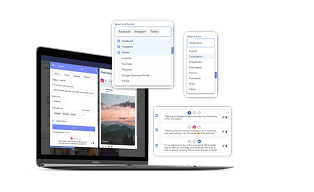

In 2020, we have the power of data at our hands like never before – and this can be incredibly valuable when making business decisions for ourselves and for our clients. Not only does data let us analyze our performance over time, but can help us refine our business and marketing strategies in order to maximize ROI. With that said, there’s almost unlimited potential to the data that you can collect and what you do with it, so – which metrics are the most important to look at?
In the world of marketing, you’ll want to know that you’re posting the very best content with the highest possible conversions, and looking at the following metrics be the key to determining that the time and money you are putting in is ultimately paying off.

Traffic: Measuring your traffic (both overall, and channel-specific) will give you a fantastic idea of where you stand, and how your performance has changed over time. Ideally, you’ll see a nice hockey stick curve in your traffic; indicating that you are reaching more consumers each and every day. Traffic can be generated organically, or with paid search techniques; so be sure to measure both separately as well as together, to ensure that you know exactly where your traffic is coming from, and what it is costing you!
Engagement: Traffic is a key metric, though Engagement is arguably more important! If you are generating high quality content with effective messaging, your posts are far more likely to leave a lasting impression on your consumers; one that might lead to a conversion later on! Be sure to track your engagement and compare this data from post to post. This will help determine the type of content you should create in the future, when to post it, and to which platforms.
Conversion Rate: One of the most-discussed metrics in Sales and Marketing is Conversion Rate. Conversion Rate, for example, determines how many consumers you’ll need to get to your page in order to make x number of sales. This metric, combined with traffic, can help you determine exactly what it’ll cost you to earn revenue; and can help you make key budgeting decisions in the future. Additionally, you can test new landing pages, or alternative messaging to see what improves your conversion rate over time.
Bounce Rate: The lower the bounce rate, the better! Your bounce rate can be defined by the percentage of visitors who navigate off your site after viewing just one page. This metric is incredibly important, as you may be paying for “clicks” to your site using paid media, (PPC), and have those “clicks” ultimately not convert. If your bounce rate is high, it may be that your keywords need tweaking, or that your website needs a facelift. If a consumer doesn’t know where to go after clicking on your homepage, this can mean big problems for you bounce rate, and ultimately your conversion.
Trending Keywords: Understanding the keywords that result in conversions will be key for maximizing your ROI. In the same way that the wrong keywords can increase your bounce rate and negatively impact your business, the right keywords can generate high-quality leads for consumers that are ready to spend money! Testing your keywords over time can be very helpful, and there are a number of great tools available to determine which may be the best for you to use.
Customer Acquisition Cost: The metrics above will all help you determine this incredibly important metric – your Customer Acquisition Cost. This metric will tell you how much money you need to spend, on average, earning a new customer. Neil Patel outlines the formula as: “Dividing all the costs spent on acquiring more customers (marketing expenses) by the number of customers acquired in the period the money was spent. For example, if a company spent $100 on marketing in a year and acquired 100 customers in the same year, their CAC is $1.00”. If your Customer Acquisition Cost is greater than the average amount that a customer will spend (the Lifetime Customer Value), you have yourself a problem!
Lifetime Customer Value: Your Lifetime Customer Value (LCV) tells you, on average, how much money you can expect each customer to spend on your product, or your clients’. Neil Patel’s flowchat illustrates how to calculate this! The higher your LCV, the better – and make sure it’s higher than your Customer Acquisition Cost!
Alongside these metrics, there are plenty more that you could be looking at – but these are some of the classic in Sales & Marketing. With marketing activities being so closely related to sales, it’s important to look at both in order to understand the impact that Marketing has on overall revenue. Tracking these metrics can help you scale your marketing efforts effectively – ultimately making your clients very happy. Let us know which of these you’ve been tracking so far, and if you think there are any more that are important to look at.
Find us on Facebook, Instagram, Twitter or LinkedIn, and let our team know!

CaptionAI: The free and easy social media caption generator
Generate engaging social media captions effortlessly with our ChatGPT-powered AI writing assistant.
.png)



